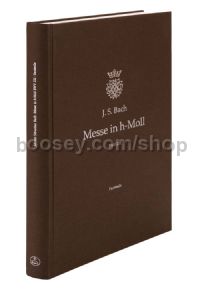Mass B minor BWV 232
Mass B minor BWV 232
Special Offer
* Estimated price converted from UK retail price
In response to a continued interest in a scholarly facsimile of the Mass in B minor, a new cloth-bound facsimile edition (BVK 2194) has now been published. This replaces the original BÄRENREITER FACSIMILE edition (BVK 1911).
Johann Sebastian Bach completed the Mass in B minor in 1748/49 shortly after the Art of Fugue and shortly before his death. This late work is as concentrated and rich in compositional technique as scarcely any other work. As early as 1818, Hans-Georg Nägeli enthusiastically described the Mass as the "greatest musical artwork of all time and all nations”. Since then it has been ranked as an icon of music history.
One of the primary functions of a facsimile is the preservation of such a cultural heritage, particularly when the manuscript (as is the case with the Mass in B minor) is endangered and damaged by iron gall ink erosion. Furthermore, it is moving for Bach admirers to see how in some passages Bach’s handwriting reflects the effort which this last work demanded of him.
The facsimile documents and records the present condition of the complete autograph score. Older reproductions have substituted a few individual folios where the content has become difficult to read in recent years.
The renowned Bach scholar Christoph Wolff describes the work’s significance in his introduction, gives an overview of the history of composition and draws attention to particular distinguishing features of the manuscript.
"This facsimile edition is a model for the presentation of musical sources, both in appearance and in documentation. […] Wolff's facsimile will serve as foundational tools"
(Notes, December 2008)
"Once, Bach came up against the boundaries of his art, on blotchy, 260-year-old paper. ‘Et expecto…’ is this point in the B minor mass, ‘And I look for the resurrection of the dead.’ Bach wrote modulations which were extraordinary. He had to strive for these. He crossed out – although this is a fair copy – hatched and scratched until the paper tore. He was already an old man, his script leans to the left. The handwriting here isn’t nearly as lively as in the ‘Cum sancto Spirito’, written earlier. Everywhere, one is moved by the closeness to the manuscript which the facsimile conveys – one of the most sumptuous ever published."
(DIE ZEIT Literatur, December 2007)




